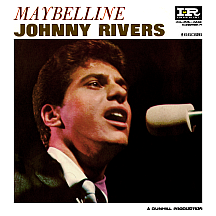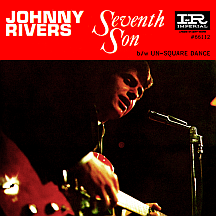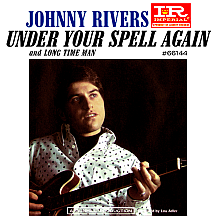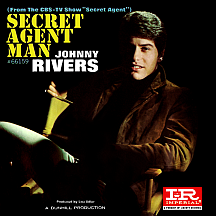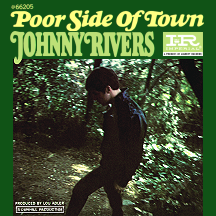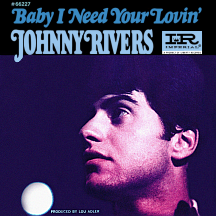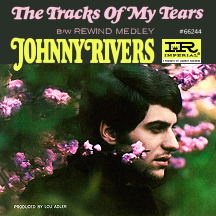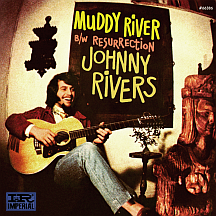JOHNNY RIVERS
A true rock and roll fan was he, this Louisiana teenager named John Ramistella, who began playing guitar around the age of eight. By that time his family had moved from New York City to Baton Rouge, a great place to soak up the sounds of New Orleans blues, jazz and rock and rollers like Fats Domino. Inspiration came from local musician Dick Holler, already out of high school and fronting a band called The Rockets; the group's bluesy, laid-back "Living by the Gun" was released on New Orleans' Ace label in 1957. John put together his own group called The Spades and recorded "Little Girl," a tight sax-and guitar tune he had written, released on the Suede label of Natchez, Louisiana as Johnny Ramistella. He was 14 at the time but sounded much older.
On a visit to New York in 1958, Johnny met disc jockey Alan Freed, who helped the young singer get in the door at George Goldner's Gone Records. Freed suggested a name change and, as a tribute to the Mississippi River so close to his heart and home, Johnny Rivers became the singer's permanent professional moniker. Gone released "Baby Come Back" (musically and lyrically very similar to Elvis Presley's "Santa Bring My Baby Back (To Me)" from the previous Christmas season). Another single, "You're the One," came out on Guyden before Johnny returned to Baton Rouge. A breakthrough came in 1961 when a song Johnny had written, "I'll Make Believe," was recorded by Ricky Nelson at the suggestion of James Burton, a Louisiana native who'd been playing lead guitar on Nelson's records since '58. The song appeared on Rick is 21, a summer '61 release that became one of Nelson's best selling albums.
Rivers made many recordings in New York and Nashville during the next few years, jumping from label to label with mostly one-shot (and non-hit) releases for Dee Dee Records, Cub, Era, Chancellor and others. He moved to Los Angeles and made an album for Capitol in late 1962 (The Sensational Johnny Rivers) featuring two singles that leaned in a country direction. The entire project fell flat; '50s rock and roll was where his head was still at. An opportunity arose that allowed him to follow his passion and perform the music he loved on a nightly basis, which resulted in a level of success beyond all expectations.
Gazzarri's Sunset Strip Supper Club in West Hollywood was between headlining acts in the fall of 1963; Johnny was hired to fill in until a permanent star could be found. His early rock repertoire and natural ease on stage began to attract crowds. Producer Lou Adler stopped by to check him out and became his manager; in January '64 a new Sunset Blvd. club, the Whisky a Go Go (the latest in a chain of nightclubs begun in Paris in the late 1940s and brought stateside a decade later), opened just three blocks from Gazzarri's and Johnny was lured away with a longer-term contract. Before long the Whisky was the hottest party place on the Strip, the first club to feature those caged "Go-Go" dancers that have become an iconic symbol of the '60s. Trini Lopez had recently become a star performer with hit singles and albums recorded live at another nearby night spot, P.J.'s; with a similar goal in mind, tapes of Johnny's live performances were sold to Imperial Records for an album release. What was, at first, just another gimmick to sell records quickly evolved into an impressive string of hits.
The front cover of Johnny Rivers at the Whisky a Go Go proudly proclaimed the album was "Recorded live, very live!" The back cover made room for plenty of glowing testimonials from top stars of the day, including Ann-Margret, Tony Bennett, Johnny Carson, Sammy Davis Jr. and Italian actress Gina Lollobrigida. The disc contained a selection of '50s and early '60s tunes: Lloyd Price's "Lawdy Miss Clawdy," Don Gibson's "Oh Lonesome Me," Rufus Thomas's "Walkin' the Dog," a medley of "La Bamba" and "Twist and Shout" and an impromptu jam titled, appropriately, "Whisky a Go Go." Going against conventional wisdom, Imperial released Johnny's live take on Chuck Berry's "Memphis" as a single (it had been a top ten instrumental hit for guitarist Lonnie Mack less than a year earlier), but this was all just a fluke anyway, wasn't it? Any thoughts along those lines dissolved when the song appeared on the national charts in May, then went all the way to number two just six weeks later. Certainly this would be a one-shot hit, but what a hit!
Then the follow-up came out and it also landed high on the charts. Staying with what worked the first time, the label released another nightclub recording of a Berry song, "Maybelline" (note the slight adjustment to the spelling of "Maybellene"), from another Whisky go-round where the tape was rolling and the cash was flowing, at the club and in record stores. A second album, Here We a Go Go Again, hit the streets within a few months of the first; both were big sellers. The nightclub was packed every night with fans and celebrities alike. Johnny went into the studio to cut his next single for Adler's Dunhill Productions; "Mountain of Love" (the Harold Dorman hit from 1960) returned him to the top ten in November '64. The oldies he loved were hot again! He was burning both ends of the candle and loving every minute of it.
More live Whisky recordings were hits in 1965, including a pair of blues numbers, the traditional "Midnight Special" (his version later used as the theme for the 1970s concert TV series of the same title) and Willie Dixon's "Seventh Son" (which became his third top ten hit). Studio tracks appeared in between: Sam Cooke's "Cupid," Pete Seeger's "Where Have All the Flowers Gone" (a hit for The Kingston Trio in '62) and the Buck Owens tune "Under Your Spell Again." He was one of the hottest acts of '64 and '65 during a period of domination by British bands...and he did it in an unconventional way!
The next hit song had already been recorded by Rivers, in early 1965, as a 40-second theme for U.S. airings of British television series Danger Man. The half hour spy series starring Patrick McGoohan as agent John Drake aired in England from 1960 through '62 and ran in the U.S. for several months on CBS in 1961. The show was revived in the fall of '64 as an hourlong series with McGoohan reprising his role; CBS aired it from April '65 to September '66 but changed the title to Secret Agent to capitalize on the popularity of the James Bond films and recent NBC hit The Man from U.N.C.L.E. Johnny's U.S.-only theme song, written by P.F. Sloan and Steve Barri, wasn't considered for release at first. Popular demand prompted him to do a live version of the song, "Secret Agent Man," that crashed the top ten in the spring of '66.
"(I Washed My Hands In) Muddy Water," another Whisky a Go Go track, came next. All total he had six live performances that became hits, more than any other act of the era. After that he focused on studio recording and hit number one in the fall with an original ballad cowritten with Adler, "Poor Side of Town." At about this time he established his own record label, Soul City (a subsidiary of parent company Liberty/Imperial), and hit the jackpot right away with The 5th Dimension, a two-woman, three-man group whose run of hits on the label from '67 to '70 surpassed even his own successful run of the previous three years.
Johnny was on a Motown kick in 1967, scoring top ten hits with the Holland-Dozier-Holland song "Baby I Need Your Lovin'" (a Four Tops breakthrough hit in '64) and Smokey Robinson's Miracles masterpiece "The Tracks of My Tears." By year's end he'd gone into a more experimental phase with a trio of songs written by Nebraska-born folk musician James Hendricks (at the time the husband of Cass Elliot of The Mamas and the Papas). "Summer Rain" paid homage to The Beatles' game-changing Sgt. Pepper's Lonely Hearts Club Band, the musical peak of 1967 if not the entire decade; "Look to Your Soul" and "Muddy River" followed in 1968.
Rivers concentrated more of his efforts on writing and producing in the late '60s and early '70s while developing new artists for Soul City (among them Al Wilson, who hit in '68 with "The Snake," which Johnny produced). He never strayed far from his rock roots and reappeared in the top ten late in 1972 with "Rockin' Pneumonia - Boogie Woogie Flu" (a New Orleans favorite from his teenage years first waxed by Huey "Piano" Smith and the Clowns in 1957). Carl Perkins' "Blue Suede Shoes" and The Beach Boys' "Help Me Rhonda" are other classics Rivers refurbished and hit big with in the mid-'70s. One last top ten hit came in 1977, Jack Tempchin's "Swayin' to the Music (Slow Dancin')." His final chart single was "Curious Mind (Um, Um, Um, Um, Um, Um)" in 1978, a curiously retitled revival of Curtis Mayfield's soul classic made famous by Major Lance 14 years earlier. Johnny Rivers has continued his association with the Whisky a Go Go, still going strong on the Sunset Strip, with occasional return engagements at the nightclub where he shot to fame.
NOTABLE SINGLES:
- Little Girl - 1957
as Johnny Ramistella - Memphis - 1964
- Oh What a Kiss - 1964
- Maybelline - 1964
- Mountain of Love - 1964
- Midnight Special /
Cupid - 1965 - Seventh Son - 1965
- Where Have All the Flowers Gone - 1965
- Under Your Spell Again - 1966
- Secret Agent Man - 1966
- (I Washed My Hands In) Muddy Water - 1966
- Poor Side of Town - 1966
- Baby I Need Your Lovin' - 1967
- The Tracks of My Tears - 1967
- Summer Rain - 1967
- Look to Your Soul - 1968
- Right Relations - 1968
- These Are Not My People - 1969
- Muddy River - 1969
- One Woman - 1969
- Into the Mystic - 1970
- Think His Name - 1971
- Rockin' Pneumonia - Boogie Woogie Flu - 1972
- Blue Suede Shoes - 1973
- Help Me Rhonda - 1975
- Swayin' to the Music (Slow Dancin') - 1977
- Curious Mind (Um, Um, Um, Um, Um, Um) - 1978


